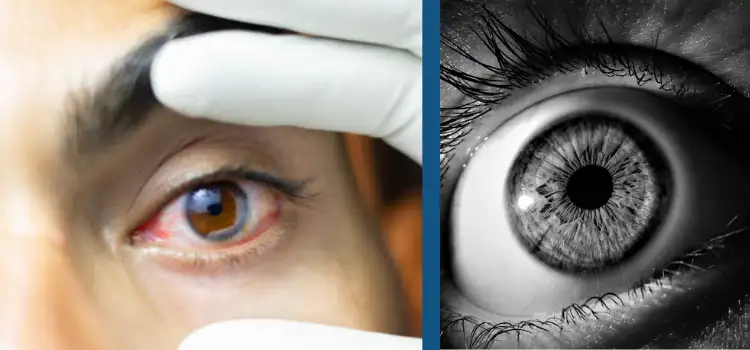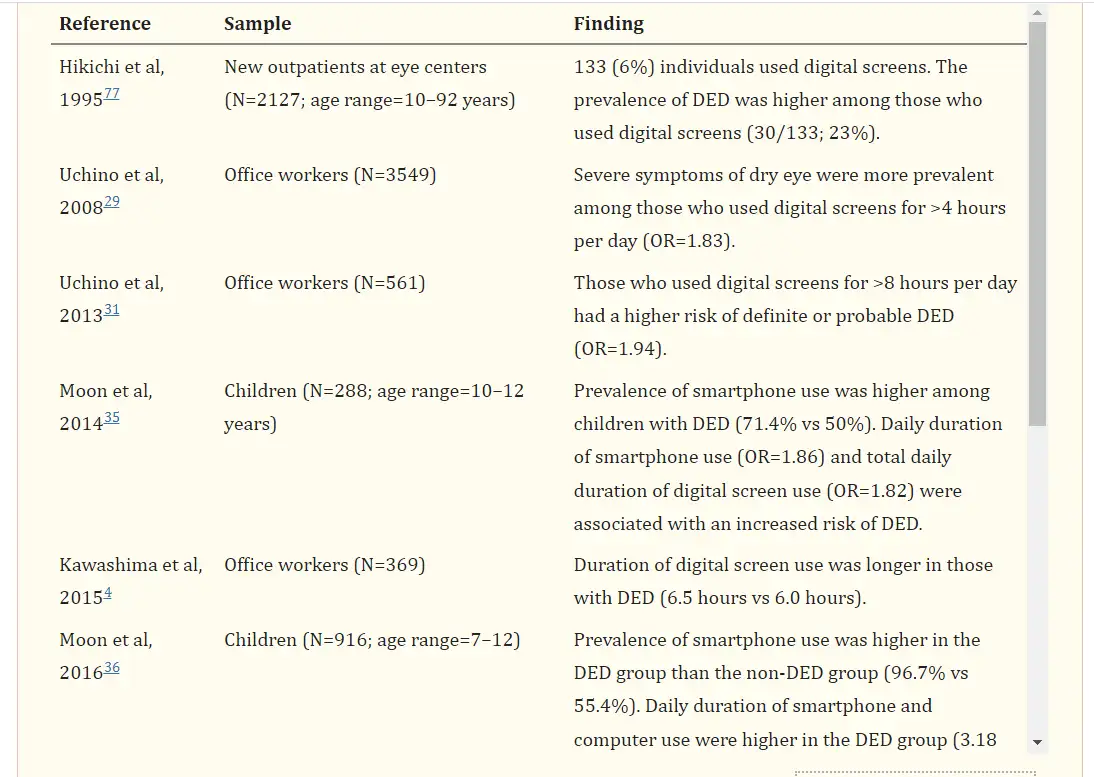Dry eyes disease is a condition whereby the eyes do not produce adequate tears to lubricate the eyes. Ocular dryness happens when the eyes cannot produce good-quality tears; this makes the tears dry up fast and the surface of the eyes become irritated and dry.
Tear film dysfunction can lead to discomfort due to the inadequate production of tears—this can cause damage and inflammation to the surface of the eyes. It can also lead to watery tears—though it helps for a while, causing the eye to feel gritty and uncomfortable. Tear deficiency may not cause serious damage in the immediate but can make you uncomfortable. In rare cases, severe cases can lead to a risk of long-term damage.

You may experience this condition after spending a long time on the screen, staying in an air-conditioned room, or riding a bike. Treatments for dry eyes include using recommended eye drops, making lifestyle changes, and more.
Dry eyes are more than just an occasional irritation—they can significantly impact daily life. This article explores the many facets of dry eye syndrome, from How Do Tears Function, Dry eyes causes and symptoms to the risk factors that increases susceptibility. We’ll dive into the methods used for diagnosis, common treatment options, and practical prevention techniques. You’ll learn about potential complications, associated conditions, and the profound effect on quality of life. With emerging treatments, current statistics, economic impact, and growing public awareness, dry eyes deserve serious attention.
How Do Tears Function?
Every time you blink, the human eye secretes a film of tears over your eyes. This fluid’s function is to keep your eyes clean and smooth. Without this tear film, your vision will be difficult. Now, what makes up this tear film is the question we must answer. Three layers make up the tear film.
- An oily layer
- A watery layer
- A mucus layer
These layers play different vital roles in making sure your eyes remain lubricated and your vision clear.
The oily layer is the outermost part of the tear film. Its role is to ensure the tears remain smooth and reduce quick evaporation of the tears. The meibomian glands of the eyes produce this oily layer.
The watery layer resides in the middle part of the tear film. This essentially represents what we perceive as tears. It is the most visible part. Its function is to clean the eyes and remove foreign objects from their environment. The lacrimal glands in the eyelids produce the watery layer.
The mucus layer is the third and innermost layer in the tear film. Its function is to spread the watery layer over the eye surface, ensuring that the eyes remain moist. The mucus is responsible for the sticky nature of the tears. Without the mucus, the tears will not stick to the eye. The conjunctiva gland is responsible for secreting the mucus layers of tears.
The production of tears is what keeps the eye moist at all times. When we cry or come into contact with an external object, our eyes secrete copious amounts of tears. But, when the amount of tears from the eyes reduces, something must have affected one or more of these layers, thereby leading to dry eyes.
Causes of Dry Eye Disease
In 2022, Mayo Foundation for Medical Education and Research stated “Dry eyes are caused by a variety of reasons that disrupt the healthy tear film. Your tear film has three layers: fatty oils, aqueous fluid and mucus. This combination usually keeps the surface of your eyes lubricated, smooth and clear. Problems with any of these layers can cause dry eyes.
Reasons for tear film dysfunction are many, including hormone changes, autoimmune disease, inflamed eyelid glands or allergic eye disease. For some people, the cause of dry eyes is decreased tear production or increased tear evaporation”.
Decreased Tear Gland
Inflammation of the glands that produce the various elements of the tear or not providing enough water, oil, or mucus (aqueous fluid) can cause dry eye disease. This is known as keratoconjunctivities sicca. Some causes of decreased tear gland are:
- Cornea nerve insentivity is caused by the use of contact lenses, laser eye surgery, and nerve damage. Symptoms of this cause are temporary.
- Aging (age over 50)
- Smoking and alcohol consumption
- Medical conditions like allergic eye disease, lupus, scleroderma, thyroid disorders, and vitamin A deficiency.
- Some medicines like decongestants, hormone replacement therapy, antihistamines, medicine for birth control, Parkinson’s disease, high blood pressure, etc.
- Sjogren’s syndrome
Increased tear evaporation
The tears, not having enough of the three layers, easily evaporate, which makes the eyes not maintain a constant supply of moisture.
The clogging of the oil film produced by the small glands on the edge of the eyelids (Meibomian glands) can be seen in people with rosacea and other skin disorders.
The common causes of increased tear eveaporation include:
- Eye allergies
- Wind, smoke, or dry and dusty air
- Laser surgery
- Posterior Blepharitis (Meibomian gland dysfunction)
- Preservatives in eye drops
- Eyelid issues like entropia (the eyelids turning inward) and ectropion (the lids turning).
Symptoms
There are several symptoms of Dehydrated eyes disease. Some common symptoms include:
- Redness of the eyes
- Sensitive to light
- Watery eyes than normal
- Blurry vision
- Itching, stinging, or burning
- Mucus
- Discomfort during screen use or reading for a long time.
- Gritty
- Sore
According to Dr. Lance Kugler, a founding member of the Refractive Surgery Alliance (RSA), many people with dry eyes notice their eyes feeling heavy.
Risk Factors
In a study carried out by Aljammaz HM et al. in Prevalence and Risk Factors for Symptomatic Dry Eye Disease, it was observed that some of the risk factors for dry eye disease have been identified. This includes older age, female gender, and use of estrogen hormone. A study discussed using a smartphone application “DryEyeRhythm” and revealed that several risk factors, including female gender, using contact lenses, smoking, prolonged periods in front of screens, having collagen disease, hay fever, and depression, can all lead to severe dry eye disease-type symptoms.
Some conditions that can increase the risk include:
- LASIK eye surgery
- Insufficient blinking
- Thyroid disease
- Keratitis
- Some medications, like nasal decongestants and antidepressants
- Facial nerve palsy
- Mild dehydration
Diagnosis
To know the cause of your dry eyes, some tests and procedures may be used. These include:
- Complete Eye Exam. This gives a complete record of your eye health and overall health. This examination can help the eye doctor diagnose the cause of the dry eye.
- A test to measure the volume of tears. Your eye doctor will use the Schirmer tear test to measure the tear production. During the test, blotting strips of paper are placed under the lower eyelids. After a few minutes, the doctor measures the amount of strip soaked by tears.
- Another method of measuring tear volume is the phenol red thread test. During the test, a thread filled with pH-sensitive dye (tears change the dye color) is kept over the lower eyelid, wetted with tears for 15 seconds, and tear volume measured.
- A test to determine the quality of tears. Special dyes are used in other tests to know the surface condition of eyes. The eye doctor checks for staining patterns on the corneas and measures how long it takes before tears evaporate.
- A tear osmolarity test. In this test, it measures the make-up of particles and water in your tears. There will be less water in your eyes if you have dry eye disease; there will be less water in your eyes.
- Tear samples to look for markers of dry eye disease, including increased matrix metalloproteinase-9 or reduced lactoferrin.
Treatment
In some cases, treatment of Dehydrated eyes disease can be frequent if it is a long-term condition. The severity of dry eye disease determines the treatment. This may include:
Eye drops and gels
Various eye drops and gels can make you comfortable and increase your eye moisture. To get the best of these drops and gels, go for the ones without preservatives or little preservatives. They help to reduce irritation. Sodium Hyaluronate gels or drops can be helpful in treating the disease. You can seek the advice of your eye doctor to get more treatment if your drops are not effective.
Medications
Inflammation on the edge of the eyelids can prevent oil glands from secreting oil in the tears. An anti-inflammatory medication known as cyclosporine can be prescribed for dry eye disease. This medication can enhance the production of tears and reduce the risk of cornea damage. Xiidra is another drug for dry eye treatment. In severe cases, corticosteroid eye drops can be used for a short period while the drug takes effect. Alternative drugs that can be used may include cholinergics, such as pilocarpine, but can be in rare cases. These medications help stimulate tear production.
Lacrimal plugs
Lacrimal plugs can be used to block holes in the corner of the eyes by an eye doctor. The blockage can reduce loss of tears, be reversible, and also be painless. In severe conditions, plugs can be considered the permanent solution by the eye doctor.
Eye Surgery
An eye surgery is recommended by the eye doctor in severe dry eye disease and when other treatment is ineffective. A permanent plug can be inserted in the drainage holes at the inner corners of your eyes to maintain an adequate amount of tears.
Procedures
Treatments like LipiFlow help tears flow more easily, and BlephEx, which an eye care professional performs to clean the eyelid.
Lifestyle Changes
Reduce your screen time by looking away from your book or screen every 20 minutes. Avoid being dehydrated, etc. Wear eyeglasses or protection to prevent wind
Prevention
Dry eyes can be prevented by knowing the cause of the symptoms. You must avoid the causes to prevent this condition, especially the environmental causes. Examples include:
- Avoid smoking and stop smoking.
- Keep your computer screen below the level of your eyes.
- Always use artificial tears.
- Take breaks on your screen time and book.
- Avoid air in your eyes.
- Be conscious of your environment.
- Wear your eyeglasses when outside.
Complications
In severe dry eye cases, the eye doesn’t provide enough tears or poor quality tears. It can cause complications like poor vision, redness, ulcers, etc. Here are some complications that happen when chronic dry eyes are not well treated.
- Blurry vision.
- Difficulty to open your eyes
- Conjunctivitis
- Corneal ulcer
- Headache
- Excessive watering
- Irritation and gritty
- Burning and itching of the eyes.
Some medical conditions are associated with dry eye disease. They include Sjogren’s syndrome, diabetes, vitamin A deficiency, rheumatoid arthritis, lupus, Grave’s disease, scleroderma, and thyroid disorders.
Impact on Quality of Life
An ophthalmologist, Laura M. Periman, MD, stated that there are a number of questionnaires that can be used to measure the impact of dry eye disease on quality of life. These include the SPEED (Standard Patient Evaluation of Eye Dryness Questionnaire), OSDI (Ocular Surface Disease Index), and the IDEEL (Impact of Dry Eye in Everyday Life).
Questionnaires are important to know the progress of dry eye treatment by quantifying its impact on daily activities, work productivity, social relationships, and movement of a person.
The Singapore Study
A journal published by The British Journal of Ophthalmology in 2021 revealed the link between dry eye disease and poor health-related quality of life. There was a reduced quality of life due to poor visual quality.
Researchers did a study to know how dry eye symptoms affect quality of life. In the study, the researchers checked the symptoms experienced by dry eye patients and how they scored on the visual function questionnaire.
With a total of over 7,700 participants, it was found that those with dry eye symptoms reported a greater lower quality of life than their counterparts who do not suffer from dry eye disease.
They concluded that “efforts to reduce the severity of dry eye symptoms are essential to optimizing patients’ overall functioning and well-being.
Emerging Treatment
Many researchers continue to try out and develop new treatments for Ocular dryness disease. Some of these treatments include eye drops (perfluorohexyloctane ophthalmic solution (Miebo), Cyclosporine, etc.) and therapies, topicals, oral medications, devices, and procedures (intense pulsed light IPL, Lipiflow, and iLux), and dietary supplements that have antioxidants and anti-inflammatory benefits. A change of lifestyle can also help in the treatment of Tear deficiency disease, like the use of humidifiers, avoiding rubbing of the eyes, applying warm compresses to the eyelids often, etc.
Statistics and prevalence of dry eye disease
An article made by the PubMed Journal estimated that approximately 16.4 million Americans (6.8% of the adult US population) have been diagnosed with dry eye disease. An additional 6 million (2.5% of adult Americans) experience dry eye symptoms but are yet to be diagnosed. The total estimated burden of disease is 9.3% of adult Americans. The prevalence is higher among women than men and increases with age. Another study found a prevalence of 11.3% among all adults greater than 50 years of age and as high as 22.8% among women greater than 75 years of age.
From the result of the study, dry eye disease may continue to increase as the population ages. The effect of dry eye on the populations is their daily activities, work, life quality, driving, etc. A recent economic analysis estimated that the average annual direct cost of managing an American dry-eye patient was $783, which, when adjusted for the prevalence of dry eye, amounted to $3.84 billion across the U.S. healthcare system.
Economic Impact of the Disease
The economic impact can be calculated by using different measures. To know the economic efficiency is by the result of a cost-benefit analysis. In the analysis, the dollar value of the benefits of a treatment is equated with the dollar value of the price of the treatment.
Research done by Allergan, Inc. (2008) stated that medical care costs due to dry eye disease are not much compared to the price of lost productivity (mostly known as indirect costs). People with mild, moderate, and severe dry eye symptoms experience $12,686, $12,569, and $18,168 of annual productivity loss, respectively. It is almost the same as losing a full-time minimum-wage worker for people with mild and moderate issues. These numbers are larger than the medical care price, which has an estimated $55.4 billion total impact on the United States economy.
Public Awareness of Dry Eye Disease
The National Eye Institute reported that “almost 16 million people are diagnosed with dry eye disease, even though many suffering from dry eye disease are undiagnosed.”
The month of July is known as Dry Eye Awareness Month to create awareness of the disease. This awareness can be done through different social media, fact sheets, web pages dedicated to the awareness, graphics, campaigns, support groups, and education programs.
Misconceptions
There are several myths out there about dry eyes. In some quarters, it was concluded that:
It is an age-related sickness. This is not true, even though it is prevalent among older people aged 50 and above. Other factors, such as environment, lifestyle, wind, smoke, and dry air, can contribute to this disease. Researchers have proven that medical conditions like Sjögren’s syndrome, allergies, and diabetes can also lead to dry eyes. A research findings by Nyulangone.org: “That means your immune system, which typically fights off infections, mistakenly attacks the body’s moisture-producing glands, causing symptoms such as dry eyes and dry mouth.” Drugs like antihistamines, antidepressants, and blood pressure medications also contribute to dry eyes. Prolonged contact lens wear can exacerbate dryness.
“It’s Not Serious“: Many people hold the belief that dry eye disease should not be taken seriously. However, research from the National Library of Medicine has revealed that dry eyes may potentially cause damage to the ocular surface. According to the Washington University School of Medicine, “dry eye disease alters how the eye’s cornea heals itself after injury,” which can in turn lead to damage to the eyes over time.

Living with Dry Eyes
Are you afflicted with dry eye disease? You are not alone in this situation. According to the National Library of Medicine, “The overall prevalence of dry eye was found to be 54.3% of the sample size of 400 participants of age 40 years and above. The prevalence of dry eye was found to be maximum in the elderly.” To live in isolation is not the best thing to do. Groups, forums, communities, and associations of people with the same disease exist. One such forum is:
The Mindbody Syndrome (TMS) Discussion Forum: You can sign up for this forum using the Dry Eye section thread. It will allow you to obtain the necessary information on how to live with and manage this disease.
Mayo Clinic Eye Condition Support Group is another reliable support group for people with dry eyes. You can sign up for the site and connect with the support group here.
Join the conversation, read stories about dry eye conditions, hear from participants at the dry eye happy hour, explore the results of dry eye disease, and participate in the survey by visiting and becoming a member of the Dry Eye Foundation. There are a lot of resources to help you manage and live with DED. Join the forum today, or you can call the foundation.
